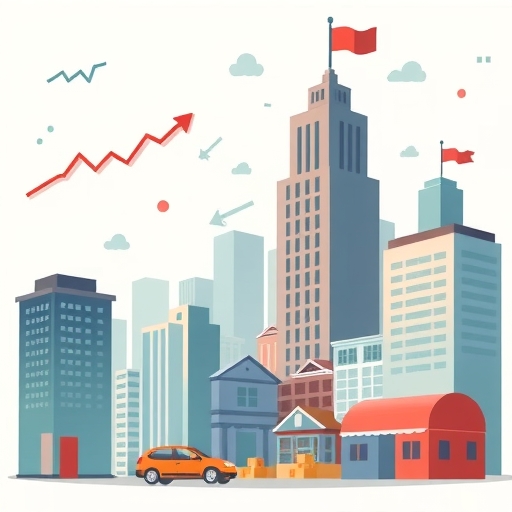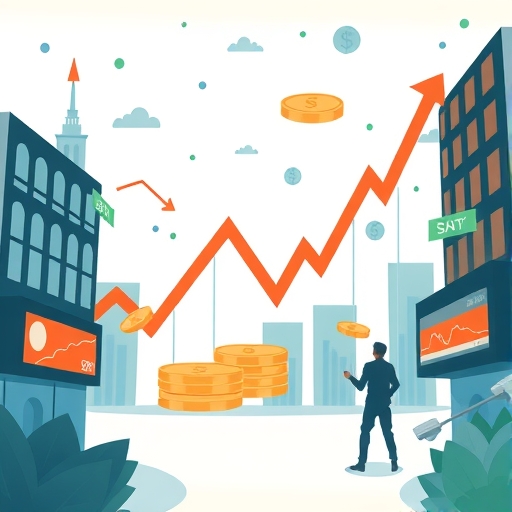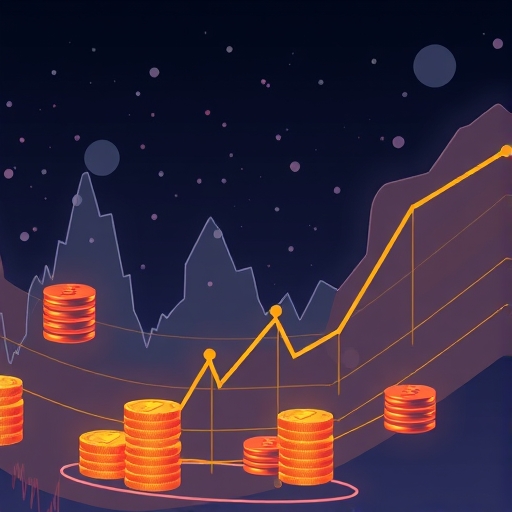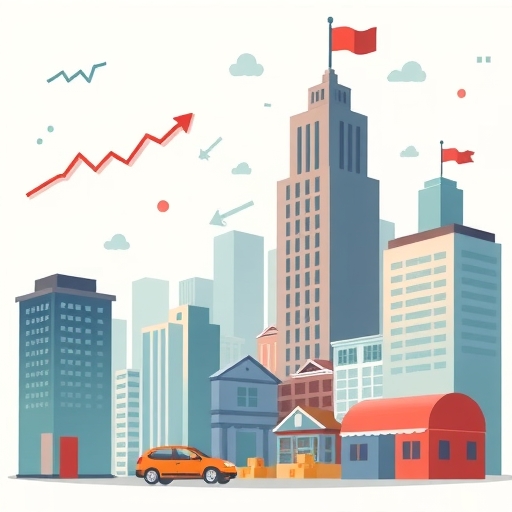Beyond Gold’s Gleam: Unlocking the Broader Potential of Commodities in 2024
Have you been captivated by gold’s stellar performance this year? It’s undeniable; gold has surged by an impressive 30% year-to-date, reaching record highs and capturing headlines. This remarkable rally has been primarily fueled by central bank accumulation and a global flight to safety amidst market uncertainties. But while gold shines brightly, are we overlooking significant opportunities lurking in the broader commodities market? 
In this article, we’ll dive deeper into the forces driving gold’s success and then broaden our perspective to explore the untapped potential across various other commodity sectors. We’ll examine how Commodity Exchange Traded Funds (ETFs) offer accessible and efficient ways to gain exposure to these markets, acting as a vital tool for portfolio diversification. Crucially, we’ll also discuss how a strategic allocation to commodities can serve as a powerful hedge against persistent inflation and the potential threat of stagflation, helping you navigate today’s complex economic landscape. Join us as we uncover why looking beyond gold’s gleam might be your next strategic financial move.
Gold’s Rally: A Deeper Look and the Call for Broader Horizons
Gold’s ascent to record highs this year is a story of more than just investor sentiment. While over 60% of financial advisors plan to maintain their gold exposure, and more than 20% intend to increase it, the primary driver has been institutional. We’re talking about central banks globally hoarding gold, treating it as a strategic reserve amidst geopolitical tensions and economic wobbles. This institutional buying, rather than retail demand through ETFs, has been the true engine behind gold’s 30% year-to-date surge. 
Factors influencing gold’s robust performance this year include a confluence of global economic and geopolitical dynamics. These elements collectively shape investor sentiment and institutional strategies regarding the precious metal.
- Geopolitical instability and ongoing global conflicts increase demand for safe-haven assets like gold.
- Concerns about currency devaluation and the long-term strength of fiat money often lead investors and central banks to gold.
- High levels of government debt and fiscal spending can contribute to inflationary pressures, making gold an attractive hedge.
This “flight to safety” narrative is powerful, but does it tell the whole story for investors seeking resilience and growth? Kathy Kriskey, Head of Alternatives Product Strategy at Invesco, advises investors to look beyond the immediate hype. She emphasizes that while gold is a valuable asset, its current rally is less about traditional ETF purchasers and more about central bank activity. For individual investors, she suggests that the real opportunity for inflation hedging and diversification often lies in buying commodities when they aren’t dominating the news cycle. This perspective encourages us to consider where else value might be hiding.
Understanding the diverse sources of gold demand is crucial for appreciating its market dynamics.
| Category | Primary Driver | Impact on Price |
|---|---|---|
| Investment | Safe-haven appeal, inflation hedge | Increases demand, pushes prices up |
| Central Banks | Reserve diversification, geopolitical stability | Significant institutional buying, strong price support |
| Jewelry | Consumer demand, cultural significance | Stable demand, sensitive to economic growth |
| Industrial | Electronics, dentistry | Niche demand, less volatile |
Unearthing Value in the Diverse Commodity Landscape
Beyond gold, the wider commodities complex presents a compelling array of investment opportunities, often overlooked by those fixated on precious metals. The Bloomberg Commodities Index (BCOM), for instance, provides a diverse snapshot, with energy making up nearly one-third, precious metals around 20%, industrial metals 16%, and agriculture filling the rest. It’s within these diverse sectors that we find powerful crosscurrents driving significant returns. 
Consider silver, which has surged by 18% this year, reaching 14-year highs. Its impressive rally isn’t just a reflection of its precious metal status; it’s heavily tied to its industrial applications. The explosive growth in industries like artificial intelligence (AI) and electric vehicles (EVs) has created a voracious demand for materials with high electrical conductivity, and silver is a key beneficiary. Bob Minter, Director of Investment Strategy at Aberdeen Investments, highlights the bullish gold/silver ratio for silver and other industrial metals, noting silver’s dual role as both a precious and an industrial metal, unlike gold’s predominantly non-industrial role.
The expanding applications of industrial metals are a testament to global technological advancements and green initiatives.
- Copper is vital for renewable energy infrastructure, electric vehicles, and urban development projects.
- Lithium and cobalt are essential for battery technology, powering the electric vehicle revolution and portable electronics.
- Nickel is increasingly sought after for stainless steel production and advanced battery chemistries.
Other commodities are also experiencing significant rallies:
- Agricultural goods like coffee and cocoa have hit record highs, while soybeans and wheat are up due to disruptive weather patterns impacting supply.
- Industrial metals such as copper are seeing a resurgence in demand, fueled by global industrial recovery and green energy initiatives.
- Even within the energy sector, while crude prices have been down for the year due to slowing global growth and non-OPEC oversupply concerns, the long-term supply-demand dynamics remain volatile and potentially lucrative.
Each commodity sector responds to a unique set of supply and demand dynamics, making diversification across them a robust strategy.
| Sector | Primary Drivers | Examples |
|---|---|---|
| Energy | Geopolitics, global growth, supply disruptions | Crude oil, Natural gas, Gasoline |
| Precious Metals | Inflation, safe-haven, industrial demand | Gold, Silver, Platinum |
| Industrial Metals | Infrastructure, manufacturing, green tech | Copper, Aluminum, Nickel |
| Agriculture | Weather, population growth, trade policies | Wheat, Corn, Soybeans, Coffee |
These examples illustrate that the commodity market is a dynamic tapestry, where distinct supply-demand forces, macroeconomic trends, and even weather patterns create unique opportunities for astute investors. By diversifying across these sectors, you can tap into a broader range of potential returns and enhance your portfolio’s resilience.
Commodity ETFs: Your Gateway to Diversified Exposure
Investing directly in physical commodities can be impractical, requiring storage, insurance, and complex logistics. This is where Commodity Exchange Traded Funds (ETFs) step in, offering a convenient and efficient way to gain exposure to commodity price movements without the hassle of physical ownership. Commodity ETFs can achieve this exposure in several ways:
- Tracking physical commodities: Some ETFs hold actual physical commodities, like gold or silver bullion.
- Using derivatives: Many broad-based commodity ETFs, especially, utilize futures contracts and options to track commodity indexes. This allows them to reflect price changes without holding the underlying physical assets.
- Investing in equity-based companies: Another approach is to invest in companies within the natural resources sector, such as mining firms or agricultural producers, whose stock performance is tied to commodity prices.
For investors seeking broad-based exposure, several major commodity ETFs stand out. Let’s look at some prominent examples:
| ETF Ticker | Full Name | Key Features | Issuer |
|---|---|---|---|
| PDBC | Invesco Optimum Yield Diversified Commodity Strategy No K-1 ETF | Largest, oldest, most liquid, actively managed, tax-efficient (no K-1 forms), employs Optimum Yield Strategy. | Invesco |
| BCI | abrdn Bloomberg All Commodity Strategy K-1 Free ETF | Tracks the Bloomberg Commodity Index, K-1 free. | abrdn |
| DJP | iPath Bloomberg Commodity Index Total Return ETN | Tracks the Bloomberg Commodity Index, Exchange Traded Note (ETN) structure. | iPath (Barclays) |
Invesco’s PDBC is particularly noteworthy. It’s not only the world’s oldest, largest, and most liquid broad-based commodity ETF, but it’s also actively managed. This active management allows it to employ an Optimum Yield Strategy, aiming to maximize returns from rolling futures contracts. A significant advantage for many investors is that PDBC does not issue K-1 tax forms, simplifying tax season. This efficiency and convenience make commodity ETFs an attractive vehicle for integrating this asset class into your investment portfolio.
Commodities as a Strategic Hedge Against Inflation and Stagflation
In today’s economic climate, the specter of inflation looms large. With inflation holding stubbornly above 4% and the Federal Reserve signaling a slower, more cautious path to easing interest rates, investors are rightly seeking robust strategies to protect their purchasing power. Historically, commodities have shown a strong positive correlation with inflation, making them a potent hedge during inflationary periods. In fact, commodities have often outperformed equities when inflation is on the rise. 
Beyond inflation, there’s a growing concern about stagflation – a challenging economic scenario characterized by high inflation, slow economic growth, and often high unemployment. While economists don’t have a consensus on its likelihood, the potential threat underscores the importance of a diversified portfolio designed for resilience. If stagflation were to materialize, traditional asset classes might struggle. So, how can commodities help?
A well-diversified portfolio that includes commodities can act as a buffer. Here are some strategies often considered for hedging against stagflation:
- Treasury Inflation-Protected Securities (TIPS): These government bonds adjust their principal value in response to inflation, offering direct protection.
- Commodities: As discussed, they tend to perform well when inflation is high, especially raw materials that become more expensive.
- Real Estate: Property values and rental income can often keep pace with, or even outpace, inflation.
- Dividend-Paying Stocks: Companies with strong balance sheets and consistent dividend payouts can provide a steady income stream.
- Cash and Short-Term Bonds: While their returns may be low, they offer liquidity and protection against long-term bond value erosion during rising interest rates.
- Defensive Sectors: Industries like consumer staples, utilities, and healthcare tend to be more resilient during economic slowdowns.
Integrating commodities into a broader investment portfolio offers distinct advantages, especially during periods of economic uncertainty.
| Benefit | Description |
|---|---|
| Inflation Hedge | Historically, commodities perform well during inflationary periods, helping preserve purchasing power. |
| Diversification | Low correlation with traditional assets like stocks and bonds, reducing overall portfolio volatility. |
| Real Asset Value | Represents tangible assets, providing a fundamental store of value independent of financial markets. |
| Stagflation Protection | Can offer resilience in environments of slow growth and high inflation, where other assets may struggle. |
By strategically allocating to diversified commodity baskets, you’re not just chasing returns; you’re building a layer of protection that historically thrives when other asset classes may falter. This low correlation to broader markets and their efficiency as an inflation hedge make commodities particularly appealing in late-stage economic cycles and periods of economic uncertainty.
Decoding Commodity Indexes: Benchmarks for Informed Investing
Just as stock market indexes like the S&P 500 help us understand the performance of the equity market, commodity indexes serve as crucial benchmarks for the commodities asset class. These indexes track the performance of specific groups or broad baskets of commodities, providing a standardized way to evaluate investment products and market trends. Understanding how they work is key to making informed decisions about commodity ETFs.
There are several major commodity indexes, each with its own methodology and composition:
- Bloomberg Commodities Index (BCOM): Formerly the Dow Jones-UBS Commodity Index, it is widely recognized and aims for diversified, liquid exposure across various sectors.
- S&P GSCI (formerly Goldman Sachs Commodity Index): Known for its production-weighted methodology, which often gives a heavier allocation to energy commodities.
- Dow Jones Commodity Index (DJCI): Another prominent index, which we’ll discuss in more detail due to its unique weighting approach.
- Rogers International Commodity Index (RICI): Created by investor Jim Rogers, this index aims for broad global commodity exposure.
- Thomson Reuters/CoreCommodity CRB Index: One of the oldest and most recognized indexes, often providing a broader, more diversified look at commodities.
These indexes use different methodologies for weighting their components and for “rolling” futures contracts (the process of closing out expiring contracts and opening new ones for future months). For example, the Dow Jones Commodity Index (DJCI) stands out for its liquidity-weighted approach and its emphasis on equal weighting across commodity sectors. Unlike some other indexes that might be heavily skewed towards energy based on production, the DJCI limits individual commodity components to a maximum of 32% and other components to 17%. This design aims for increased diversification, which can lead to more stable and potentially superior performance over time compared to indexes with more concentrated allocations. When considering a broad-based commodity ETF, understanding which index it tracks and that index’s methodology can significantly impact your investment outcome.
Conclusion: Beyond the Headlines to Strategic Commodity Allocation
While gold has undeniably been a standout performer, capturing investor attention with its record-breaking rally, a deeper analysis reveals that the broader commodities market offers a wealth of compelling, yet often undervalued, opportunities. We’ve seen how industrial metals like silver are benefiting from burgeoning demand in cutting-edge industries, and how agricultural commodities are responding to global supply dynamics. These diverse sectors, driven by unique macroeconomic trends and supply-demand forces, present avenues for growth and resilience that extend far beyond precious metals alone.
For the savvy investor, Commodity ETFs provide an accessible, efficient, and often tax-advantaged pathway to tap into this dynamic asset class. Funds like Invesco’s PDBC offer diversified exposure and active management designed to optimize returns. Moreover, in an economic environment marked by persistent inflation and the potential threat of stagflation, commodities stand out as a crucial component of a truly diversified portfolio. Their historical ability to hedge against rising prices and their low correlation to traditional asset classes make them an invaluable tool for protecting and growing your wealth.
The wisdom in investing often lies not in chasing the latest headlines, but in a thoughtful, long-term allocation to assets that fulfill specific strategic roles within your portfolio. By understanding the diverse landscape of commodities and leveraging efficient investment vehicles, you can strategically position yourself to navigate market uncertainties and unlock potential returns from this essential asset class.
Disclaimer: This article is for informational and educational purposes only and does not constitute financial advice. Investing in commodities and ETFs involves risks, including the potential loss of principal. Before making any investment decisions, please consult with a qualified financial professional to assess your individual circumstances and risk tolerance. Past performance is not indicative of future results.
Frequently Asked Questions (FAQ)
Q: Why are commodities considered a good hedge against inflation?
A: Commodities, particularly raw materials like oil, metals, and agricultural products, tend to rise in price when inflation increases. This is because they are the fundamental inputs for goods and services, so their cost is directly reflected in the overall price level. Their positive correlation with inflation makes them a valuable tool for preserving purchasing power during inflationary periods.
Q: What is the main advantage of investing in Commodity ETFs over physical commodities?
A: The main advantage of Commodity ETFs is convenience and accessibility. They allow investors to gain exposure to commodity price movements without the logistical challenges of storing, insuring, or transporting physical assets. ETFs are also typically more liquid and can offer diversified exposure to a basket of commodities through a single investment, simplifying portfolio management and reducing transaction costs compared to direct futures trading.
Q: How do central bank actions influence gold prices?
A: Central banks significantly influence gold prices through their accumulation or sale of gold reserves. When central banks globally hoard gold, often as a strategic reserve amidst geopolitical tensions or economic instability, it creates substantial institutional demand that can drive prices higher, as seen in recent years. This institutional buying can be a more powerful driver than individual retail investor demand.



No responses yet